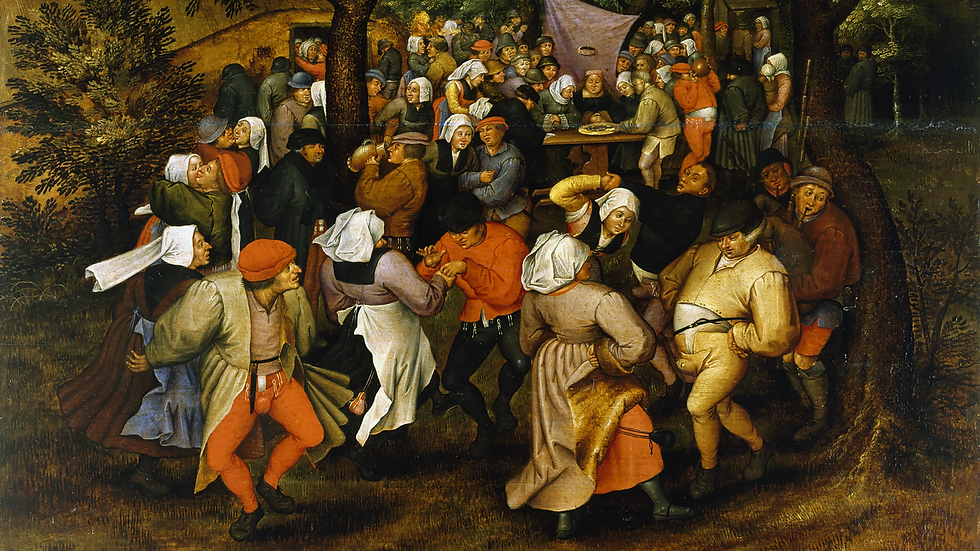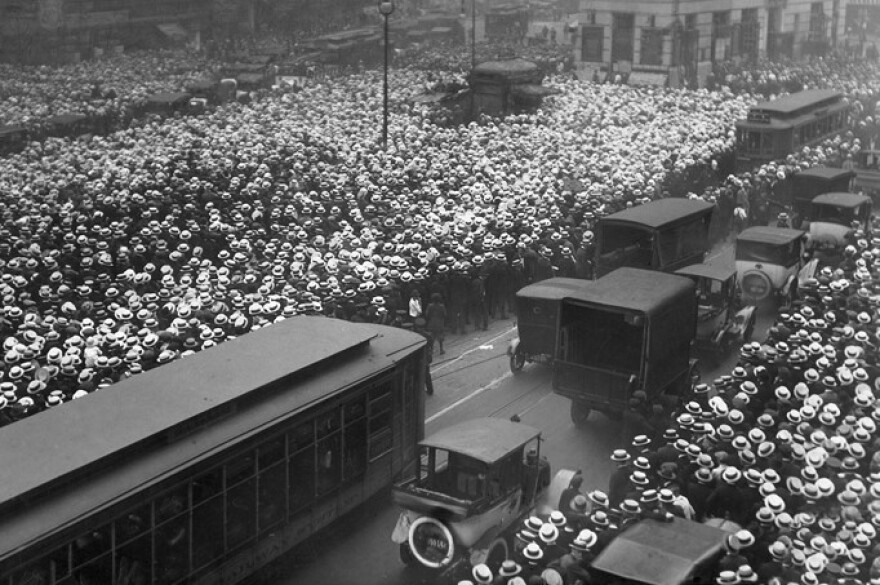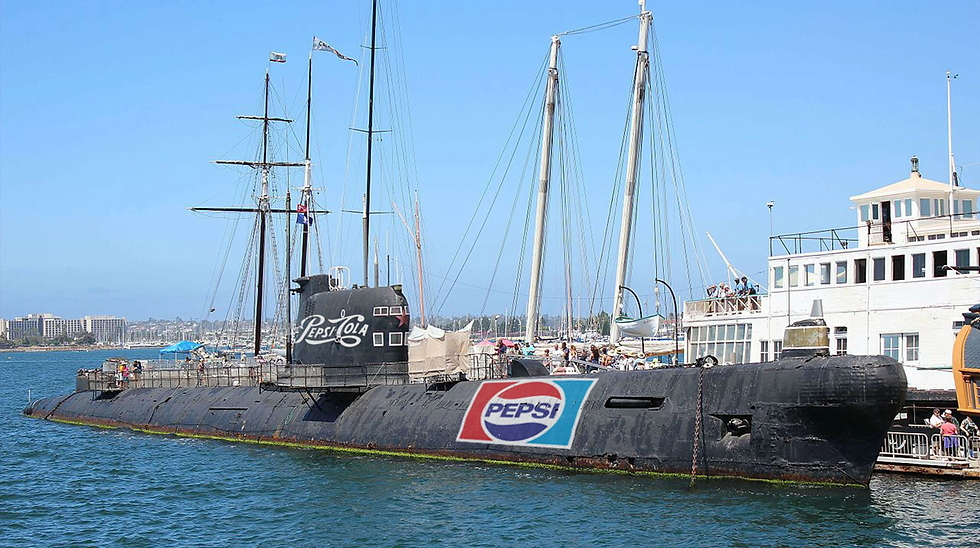A Kaleidoscope of Strangeness
- tripping8
- Mar 30, 2024
- 15 min read
In the vast tapestry of human history, there are threads so bizarre, so utterly peculiar, that they seem to have been spun by the hands of fate in a moment of whimsy. From rhinos delving into politics to straw hats causing riots, the annals of our past are riddled with moments that defy expectation and logic. These are not tales of ordinary happenstance; they are the peculiarities that make history an endlessly fascinating spectacle, where the absurd and the extraordinary converge in a kaleidoscope of strangeness.
For those of you who have been reading our posts for the past nearly two years, you know that we are fascinated by the strange and the unusual. And today we’re going to explore some strange “first’s”, some strange historical events that really happened, and maybe some just plain strange facts. But these are not mere footnotes in the annals of time; they are the enigmatic moments that render history a captivating spectacle, where the ordinary and the extraordinary collide in a dance of eccentricity.
Join us today on a whistle-stop tour of moments when history transcended the mundane and ventured into the realm of the absurd, leaving us sometimes captivated, sometimes laughing, and sometimes just shaking our head in wonder. Today we’re taking a look at some happenings that help us to realize – as if we didn’t know already – that truth really is stranger than fiction.
The Dancing Plague: It was just another July day in 1518 when Frau Troffea began to dance in the streets of Strasbourg. Onlookers apparently laughed and clapped at her energy and joie de vivre. However, it soon became clear that this was not just a simple case of high spirits. Frau Troffea continued to dance, and dance, and dance, without rest, for six solid days. Within a week, 34 people had joined her; by the end of the month, 400. At the height of the dancing mania, 15 residents were dying each day from strokes, heart attacks, and sheer exhaustion.
In a valiant attempt to fight fire with fire, the town officials tried to cure the outburst by hiring musicians and building a huge stage in the hope that the mania would soon burn out. Unfortunately, they simply encouraged more people to join the craze. At the end of 30 days the dancing stopped as abruptly as it started. The cause of all this was never determined. But, for those dancers that survived, we can assume that the result for them was incredibly toned calf muscles.
Anti-Comet Pills: Halley’s Comet has been a steady fixture of the night sky for thousands of years, dropping by, right on schedule every 75-ish years. During its pass at the earth in 1910, scientists were able to observe it closely for the first time. Unfortunately, that also led to wild speculation on some astronomers’ parts, particularly after cyanogen, a toxic gas, was discovered in the tail.
In response to the growing hysteria, enterprising individuals sought to capitalize on people's fears by offering various remedies and products claiming to protect against the supposed dangers of the comet. One of the most notable products to emerge during this time were the "Anti-Comet Pills."
These were marketed as a preventative measure against the perceived harmful effects of the comet's tail, which some believed would suffocate all life on Earth. The pills were touted as being able to neutralize the toxic fumes and safeguard individuals from the impending apocalypse. The pills became a sensation, selling to anxious consumers eager to protect themselves and their loved ones. Needless to say, the comet’s passage came and went without incident, let alone a mass-extinction event.
The Polish Army Enlists a Bear: During World War II, while transporting refugees west from Iran in 1942, the 22nd Artillery Supply Company of the Polish Army encountered an orphaned Syrian brown bear cub, which they subsequently adopted as a mascot. Named Wojtek, which means “happy warrior” or “smiling warrior”, the bear grew up and became an integral part of the unit, forming close bonds and participating in the soldiers’ daily routines. He would march alongside the soldiers, wrestle with them, and even share their rations, developing a particular fondness for beer and cigarettes.
When the ships that would take them to Italy denied him entry due to forbidding mascot animals, the 22nd enlisted Wojtek officially into the army as a private. But it was his unexpected assistance in carrying ammunition during the Battle of Monte Cassino that truly cemented his place in military history. With strength and determination, Wojtek helped transport crates of artillery shells, earning him a promotion to the rank of corporal in the Polish Army. After the war, Wojtek retired from service, living out the remainder of his life at Edinburgh Zoo in Scotland.
Straw Hat Riots of New York: It all began innocuously enough at the beginning of September 1922. Traditionally, Labor Day marked the end of summer and the unofficial ban on wearing straw hats. Men would switch to felt hats as a signal of the changing seasons and fashion norms. However, this year, a group of young rebels defied this unwritten rule and continued to flaunt their straw hats well past Labor Day. Their defiance sparked outrage among some of the more traditional-minded citizens, who saw it as a breach of social etiquette and an affront to tradition.
Tensions simmered until September 13, 1922, when the situation reached a boiling point. In what can only be described as a spontaneous eruption of collective frustration, groups of hat-wearing individuals clashed with those enforcing the unwritten ban. Felt-hat-wearing mobs roamed the streets, targeting anyone still sporting a straw hat with verbal abuse, hat-snatching, and even physical violence.
The violence quickly escalated, with fights breaking out across the city. Police struggled to contain the chaos as brawls erupted in parks, on street corners, and in theaters. Straw hats were torn apart, trampled on, and set ablaze as the conflict spiraled out of control.
The riots lasted for several days, resulting in numerous injuries, arrests, and extensive property damage. Eventually, order was restored, but the incident left a lasting impression on the city's collective memory - all over hats! Of course, America was in the midst of Prohibition at the time, so people were probably pretty angry already...
The 1904 Olympic Marathon Debacle: The 1904 Olympic Marathon, held as part of the Summer Olympics in St. Louis, Missouri, USA, stands out as one of the most bizarre and chaotic events in the history of the modern Olympic Games.
The marathon was initially scheduled to be a grueling 40-kilometer (24.85 miles) race through the streets of St. Louis, in scorching heat and dust. However, what unfolded was a series of mishaps, controversies, and extraordinary circumstances that would forever be remembered as the "1904 Olympic Marathon debacle."
The race began early on a hot August morning, with a field of 32 athletes representing various nations.
Almost immediately, chaos ensued. The poorly marked course, combined with the lack of clear directions for the runners, led to widespread confusion. There were seven hills, some with brutally long ascents. In many places cracked stone was strewn across the roadway, creating perilous footing, and the men had to constantly dodge cross-town traffic, delivery wagons, railroad trains, trolley cars, and people walking their dogs. There were only two places where athletes could secure fresh water, from a water tower at six miles and a roadside well at 12 miles. James Sullivan, the chief organizer of the games, wanted to minimize fluid intake to test the limits and effects of purposeful dehydration, a common area of research at the time. Adding to the spectacle was the presence of several unconventional competitors. One participant, a Cuban mailman named Félix Carbajal, had hitchhiked his way to the race and arrived at the starting line in street clothes. During the race, he stopped at an orchard and snacked on a couple of apples, which turned out to be rotten. Shortly thereafter, suffering from stomach cramps, he lay down and took a nap.
Another entrant, Frederick Lorz, was also suffering stomach cramps. At the nine-mile mark he decided to hitch a ride in an accompanying automobile for the remaining distance of the race. Near the finish line, he emerged from the car and ran through the tape. The crowd began cheering, a wreath was placed on his head and, just as the gold medal was about to be lowered around his neck, someone called him out. The cheers turned to boos and Lorz smiled, claiming he’d never intended to accept the honor; he finished only for the sake of a “joke.”
The most notorious figure of the marathon, however, was Thomas Hicks, an American runner who struggled through the race due to the intense heat and dust. To keep him going, his handlers administered a combination of strychnine (a rat poison) and egg whites, followed by doses of brandy. Hicks staggered and hallucinated as he continued, with his handlers even having to physically support him at times. Despite these bizarre interventions, Hicks managed to cross the finish line first, collapsing into the arms of his handlers.
His victory was marred by controversy, as it was evident that he had received substantial assistance throughout the race. In the aftermath of the marathon, the International Olympic Committee (IOC) made significant changes to the rules and regulations governing future Olympic marathons.
In 1989 Pepsi Had the World’s 6th Largest Military: It all started at the American National Exhibit in Moscow in 1959 when then-president Richard Nixon and Soviet leader Nikita Khrushchev became locked in the infamous Kitchen Debate, an argument about the perks of capitalism versus communism. To cool down the heated discussion, Donald Kendall, then head of Pepsi’s international division, told Nixon to offer Khrushchev a taste of the fruits of capitalism’s labor: Pepsi.
It was love at first sip for Khrushchev, who urged his comrades to join him in trying the tasty beverage.
Kendall had taken a risk having Pepsi appear at the American National Exhibit as the higher-ups thought the effort was a waste of time and money. Kendall told Nixon that he “had to get a Pepsi in Khrushchev’s hand” to preserve his reputation. It took several years and a lot of negotiating until all of Russia could finally share a Pepsi with their comrades in 1972.
However, since the Soviet ruble had no value outside of Russia, both parties had to resort to more traditional bartering methods to reach a deal. In exchange for every bottle of Pepsi sold, Russia would provide the soda giant with an equal amount of Stolichnaya vodka to resell in the U.S. By the late 1980s, Pepsi realized that Russia’s soda consumption far outpaced the power of the American drinking class. Combined with a lack of sales due to Americans protesting the Soviet-Afghan war, they had a surplus of vodka and a shortage of cold hard cash. With an untransferable currency and now vodka off the table, Russia was scrambling for a new way to satisfy its bubbling yearning. There seemed to be only one outrageous option: using the country’s abundance of military vehicles to win the battle of the thirst. In a bizarre agreement, Russia sold Pepsi 17 submarines, a frigate, a cruiser, and a destroyer in 1989 to keep soda flowing into its citizens’ mouths. While Pepsi soon sold their newfound fleet to a Swedish company who scrapped it, for a brief moment, Pepsi had the sixth largest naval fleet in the world!
Kendall was aware of the irony of Russia handing a U.S. corporation a military fleet, telling then US National Security Advisor, Brent Scowcroft he was “disarming the Soviet Union faster than you are.”
The First Traffic Ticket: The world’s first speeding ticket was given to Walter Arnold in Paddock Wood, Kent, England on January 28, 1896. Arnold was tearing through the town at four times the speed limit and a five-mile chase ensued before he was finally brought to a halt by a bobby on a bicycle who nailed him for going 8-mph in a 2-mph zone.
But you can’t really blame Arnold. After all, the speedometer hadn’t even been invented yet when he was summoned to court and fined a shilling.
Phone Booth Stuffing: Phone booth stuffing was a bizarre fad that emerged in the late 1950s and early 1960s, primarily among high school and college students. The objective of phone booth stuffing was to see how many people could cram themselves into a telephone booth, sorta like olives in a jar. The origins of phone booth stuffing are somewhat murky, but the trend is believed to have started in the early 1950s as a harmless and humorous prank among students. It gained widespread attention and popularity after it was featured in a photograph in the January 1959 issue of Life magazine. The photo depicted a group of young men cramming themselves into a phone booth, capturing the imagination of the public and inspiring countless imitators.
The fad quickly spread across North America, with groups of students attempting to break records and outdo each other by stuffing as many people as possible into phone booths of various sizes. Some participants even employed creative strategies, such as removing clothing or contorting their bodies, to fit more people into the confined space.
The world record for phone-booth stuffing came in March 1959, when 25 people in South Africa piled into a booth. The phone actually rang during the stunt, but no one could answer it. Phone booth stuffing reached its peak in 1959 and 1960 before gradually fading into obscurity, replaced today by seeing how many people can squeeze into an Apple store whenever the latest product is released.
The Rhino Who Won by a Nose: It’s 1959 and the voters of Sao Paulo, Brazil’s most populous city were pissed off at the slate of candidates running for election (sound familiar?). They faced a crowded field of 540 candidates, competing for 45 seats on the city council. Few inspired confidence, and many were corrupt or outright criminal (sound familiar??). Faced with such dismal options, a group of students, who were dissatisfied with the political landscape, sought to express their frustration in a creative and attention-grabbing manner. They decided to nominate Cacareco, a five-year old female black rhinoceros - who was, at the time, residing in the São Paulo Zoo - as a candidate. As they put it: “Better to elect a rhinoceros than an ass.”
To their surprise, Cacareco's candidacy gained traction among disillusioned voters who saw her as a refreshing alternative to the usual slate of candidates. Campaign slogans such as "Vote for Cacareco, the rhinoceros. Worse than it is, it can't get!" struck a chord with many people who were fed up with traditional politics. On election day, Cacareco's popularity became evident as she charged to first place and won in a landslide. The rhino received over 100,000 votes, 15% of the total cast, securing her a seat on the city council.
The outcome of the election was met with a mix of amusement, disbelief, and outrage. As The New York Times reported, Cacareco “earned one of the highest totals for a local candidate in Brazil’s recent history.” It was actually the highest total number of votes ever won by any city council candidate until then. A sore loser, the party leader complained bitterly: “A ridiculous vote for a ridiculous rhinoceros. Nowhere, and never before, have 100,000 literate adult voters cast their ballots for a silent, absent, and nut brained quadruped.” While some saw it as a lighthearted protest against the status quo, others criticized it as a mockery of the democratic process. In the meantime, the Sao Paulo zoo’s director asked the city to pay Cacareco’s City Councilman salary. However, the fix was in, election officials nullified her ballots, and the seat was awarded to the candidate with the next highest number of legitimate votes.
And Speaking of Politics: Texan Tom Moore garnered plenty of accolades throughout a productive life as a District Attorney, compassionate lawyer, and reformist legislator. He practiced law into his 90s, and in Mclennan County, he received the highest honor bestowed upon any attorney: judges no longer required him to wear a tie in their courtrooms.
During his time serving in the Texas House of Representative, from 1967 to 1973, Moore grew annoyed with the numerous resolutions being passed, even though nobody was reading them. So, he decided to show his colleagues the error of their ways. On April 1st, 1971, Moore thought it would be funny to propose a resolution to honor an esteemed American, Albert DeSalvo. The resolution praised DeSalvo for: “his dedication and devotion to his work … He has been officially recognized by the state of Massachusetts for his noted activities and unconventional techniques involving population control and applied psychology.” The honoree’s name might ring a bell for some. After the resolution passed by a unanimous vote, Moore let his colleagues know that they had just officially honored the Boston Strangler.
Merck’s Ecstatic Discovery: For all those who have sweated profusely while having feelings of intense love for everything from furniture to the cosmos, the story of how pharmaceutical company Merck invented the drug Molly, also known as MDMA or Ecstasy, will probably have little impact.
MDMA was first synthesized in 1912 by Merck while they were investigating potential pharmaceutical applications for appetite suppression for soldiers in the German army along with a blood clotting agent. The embryonic ecstasy was quickly shelved after the human test subjects started to show bizarre side effects. A squad of German troops grimacing and taking their shirts off to the marching band may well have been enough to scare even the most innovative scientists away from taking the testing further.
15 years later a chemist with Merck stumbled over the original patent for MDMA and began conducting new tests with the drug, which he described as having a similar structure to adrenaline, but his research was short-lived due to costs. Ecstasy didn't make it into the human system until the early 1950s when the US Air Force conducted secret tests with MDMA and other drugs. MDMA was no longer a secret at this point and the first official recipe for ecstasy appeared in a Polish scientific journal in 1960. Ten years later the first seizure of ecstasy tablets was reported in Chicago. The drug then made it into the mainstream in the late 1970s after Alexander Shulgin, a former scientist with the chemical company Dow, synthesized the drug and later tested it on himself. Shulgin became a fan and soon his exhortations in favor of the drug brought ecstasy to the attention of a wider audience. Because of this, he is widely credited as the "godfather" of ecstasy.
However, Merck’s report on MDMA makes clear that ecstasy was in fact created by a little-known German chemist who died four years after he discovered it and had no idea what a lasting legacy his failed blood-clotting agent would have.
First Computer Bug: A software bug is an error, flaw or fault in the design, development, or operation of computer software that causes it to produce an incorrect or unexpected result, or to behave in unintended ways. Wikipedia.
The first recorded instance of a "bug" in a computer system occurred in September 1947 with the Mark II computer at Harvard University. The Mark II computer, a large electromechanical machine, was being used for calculations when operators encountered a persistent problem. They discovered that a moth had become trapped in one of the machine's relay contacts, causing a short circuit and leading to errors in the calculations. In a logbook entry dated September 9, 1947, one of the operators, Grace Hopper, wrote: "First actual case of bug being found." She taped the moth to the logbook and wrote, "The bug was found."
This incident gave rise to the popular use of the term "bug" to describe technical glitches in computer systems.
World’s First Selfie: The world's first selfie can be traced back to the 19th century, long before smartphones and social media made selfie’s commonplace. The pioneering selfie was taken by Robert Cornelius, an American photographer, and lamp manufacturer, in 1839. Cornelius was experimenting with photography in the back of his family's store in Philadelphia, Pennsylvania. He set up his camera in front of the store's entrance, removed the lens cap, then quickly ran into the frame to position himself in front of the camera's lens. After standing still for several minutes to ensure a clear exposure, he replaced the lens cap and processed the photograph.
The resulting image, known as the "Boulevard du Temple," shows Cornelius standing off-center, slightly blurry due to the long exposure time required by early photographic techniques. Cornelius inscribed the back of the photograph with the words "The first light picture ever taken, 1839," making it clear that he was aware of the significance of his experiment. While not an instantaneous "click-and-shoot" selfie in the modern sense, Cornelius's self-portrait represents a pioneering moment in the history of photography and self-expression.
The Naked Truth: Streaking – “the act of running naked through a public space.” One of the earliest documented instances of streaking took place on March 5, 1974, at the University of North Carolina at Chapel Hill. A student named Robert "Bob" Rimmer streaked across the university's quad during a campus event, prompting a mixture of shock, laughter, and applause from onlookers.
Rimmer's streaking escapade was covered by the media and sparked a wave of imitators and copycat streaking incidents on college campuses across the United States and around the world. Michael O'Brien was the first-known streaker at a major sporting event when, on 20 April 1974, he ran out naked onto the ground of an England–France rugby union match at Twickenham, England. The 25-year-old Australian was captured by a policeman who covered his genitals with his police helmet.
(This may have been the inspiration for the title of that famous novel “A Hat full of Ralph.”) Streaking became a cultural phenomenon reaching its peak in the mid-1970s with notable streakers “appearing” at the 1974 Oscars Ceremonies,
and in the middle of Johnny Carson’s Tonight Show monologue on March 28, 1974
And so, we’ve come to the end, literally, of our look at moments through history, distant and not-so-much, that have defied logic and explanation. We’ve been reminded of the power of mass hysteria and the lengths to which people will go in search of reassurance in uncertain times. We’ve seen fascinating glimpses into the complexities of urban life and the strange ways in which seemingly insignificant events can spiral into larger cultural phenomena.
It’s incredible to think about the ways in which history unfolds, defying expectations and logic, and leaving us with tales that are both amusing and thought-provoking. Despite brief moments in the spotlight, we’ve been reminded of the peculiar ways in which people have sought entertainment and camaraderie throughout the ages. And we’ve seen how politics, in its purest and most uncorrupted forms, can use the power of satire and protest to challenge entrenched political systems and spark intelligent public dialogue.
As we wrap up this exploration of the strange and the wondrous, let’s never forget the fact that truth is nearly always stranger than fiction. In the tapestry of human existence, it is the threads of absurdity and peculiarity that add depth and richness to the fabric of our collective memory. So let us raise our glasses to the weird, the wacky, and the wonderful, for it is in these moments of strangeness that we find the true essence of our shared humanity.
#weird #wacky #wonderful #strange #keystone #rhino #plague #dance #comets #astronomy #bear #poland #wwII #worldwartwo #newyork #hats #olympics #marathon #pepsi #sovietunion #nixon #navy #submarine #vodka #traffic #speeding #ticket #phone #apple #politics #election #brazil #texas #molly #ecstasy #mdma #drugs #bugs #computer #selfie #naked #streaking #oscars #academyawards #johnnycarson #tonightshow #truth #anyhigh





































News of the weird for certain
You continue to find amusing facts! Thank you!
My favorite has to be the straw hat vs felt hat riots! Hilarious ridiculousness! Although the election of the rhino is pretty good!
You may have or not have read about the Texas man who legally changed his name to “none of the above”. He actually might gather quite a few votes!
I know you don’t like covering political things much, but when you are ready, it would be an interesting view of the DJT craze. I mean, the crazier he sounds, the more loyal his loyalists become. It has been quite fascinating to follow this election campaign.
Any one of the items would keep other candidates out! Remember Howard Dean an…